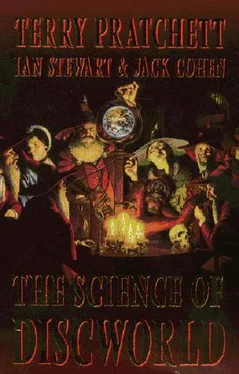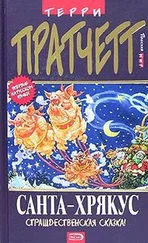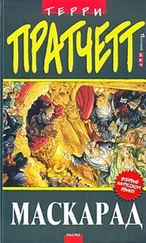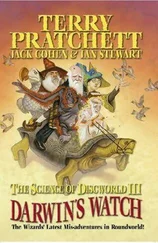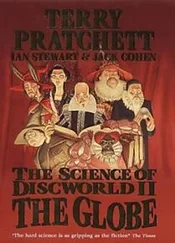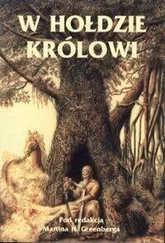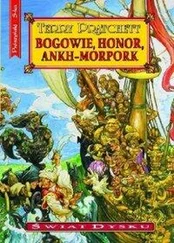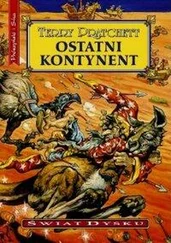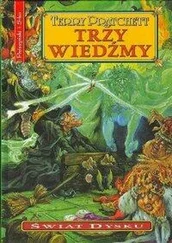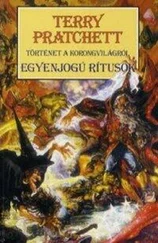Terry Pratchett - Science of Discworld
Здесь есть возможность читать онлайн «Terry Pratchett - Science of Discworld» весь текст электронной книги совершенно бесплатно (целиком полную версию без сокращений). В некоторых случаях можно слушать аудио, скачать через торрент в формате fb2 и присутствует краткое содержание. Жанр: Фантастика и фэнтези, на английском языке. Описание произведения, (предисловие) а так же отзывы посетителей доступны на портале библиотеки ЛибКат.
- Название:Science of Discworld
- Автор:
- Жанр:
- Год:неизвестен
- ISBN:нет данных
- Рейтинг книги:4 / 5. Голосов: 1
-
Избранное:Добавить в избранное
- Отзывы:
-
Ваша оценка:
- 80
- 1
- 2
- 3
- 4
- 5
Science of Discworld: краткое содержание, описание и аннотация
Предлагаем к чтению аннотацию, описание, краткое содержание или предисловие (зависит от того, что написал сам автор книги «Science of Discworld»). Если вы не нашли необходимую информацию о книге — напишите в комментариях, мы постараемся отыскать её.
Science of Discworld — читать онлайн бесплатно полную книгу (весь текст) целиком
Ниже представлен текст книги, разбитый по страницам. Система сохранения места последней прочитанной страницы, позволяет с удобством читать онлайн бесплатно книгу «Science of Discworld», без необходимости каждый раз заново искать на чём Вы остановились. Поставьте закладку, и сможете в любой момент перейти на страницу, на которой закончили чтение.
Интервал:
Закладка:
There was probably something you could do with a stick, he thought. Hopefully, it might involve sex.
He poked around in the debris and found not a stick but a dried-up thighbone, which had a sufficiently stick-like shape.
He rattled it on the ground a few times. It didn't do anything much. Then he reluctantly decided it would probably be impossible to mate with at the moment, and hurled it high into the air.
It rose, turning over and over.
When it fell, it knocked him unconscious.
The Senior Wrangler was sitting under a virtually-there beach umbrella when the other wizards arrived. He looked as downcast as the Dean.
A group of apes was playing in the surf.
'Worse than the lizards,' he said. 'They had some style, at least. When this lot pick up anything, they try to see if they can eat it. What's the point of that?'
'Well, I suppose they can find out if it's edible,' said Ridcully.
'But they just mess about ,'said the Senior Wrangler. 'Oh, no ... here we go again ...'
There was a raucous shrieking as the tribe rushed out of the waves and swung up into the nearby mangrove trees. A shadow sped beyond the surf and headed back into the blue water, to an unregarded chorus of simian catcalls and mangrove seeds.
'Oh yes, and they like throwing things,' said the Senior Wrangler.
'Seafood is good for the brain, my granny always said,' said Ridcully.
'This lot couldn't eat too much of it, then. Yell, throw things, and prod stuff to see what it does, that's the extent of their capabilities. Oh, why didn't we discover the lizards earlier? They had class?'
'Wouldn't have stopped the snowball,' said Ridcully.
'No. You were right, Archchancellor. It's so pointless.'
The three wizards stood looking gloomily out to sea. In the middle distance, dolphins stitched their way across the water.
'Should be coming up to coffee time,' said the Dean, to break the silence.
'Good thinking, that man.'
Rincewind was wandering in the next bay, staring at the cliffs. Oh, things were killed off on the Discworld, but... well... sensibly. There were floods, fires and, of course, heroes. There was nothing like a hero for a species whose number was up. But at least some actual thought went into it.
The cliff was a series of horizontal lines. They represented ancient surfaces, some of which Rincewind had virtually walked on. And in many of them were the bones of ancient creatures, turned into stone by a process Rincewind did not understand and rather distrusted. Life had some how come out of the rocks of this world, and here you could see it going back. There were whole layers of rock made out of life, millions of years of little skeletons. Faced with a natural wonder on that scale, you could only be overawed by the sheer chasms of time or else try to find someone to complain to.
A few rocks fell out, halfway up the cliff. A couple of small legs waved uncertainly in the strata, and then the Luggage tumbled out, slid down the pile of debris at the foot of the cliff, and landed on its lid.
Rincewind watched it struggle for a while, sighed, and pushed it the right way up. At least some things didn't change.
ANTHILL INSIDE
You KNOW WHAT'S GOING TO HAPPEN TO THE APES -they're going to turn into us. But why do we have them playing in the surf? Because it's fun? Yes ... but more significantly, because the seashore is central to one of the two main theories about how our ape ancestors acquired big brains. The other, more orthodox theory places the evolution of the big brain out on the African savannahs, and we know that some of our ancestors lived on the savannahs because we've found fossils. Unfortunately, seashores aren't a good place to leave fossils. You often find them there, but that's because they were deposited when the area wasn't a seashore at all, and the sea has subsequently eroded the rocks to expose the fossils. In the absence of direct evidence of this kind, the surfing apes theory has to take second place ... but it does explain our brains rather neatly, whereas the savannah theory rather sidesteps this issue.
Our closest living relatives are two species of chimpanzee: the standard boisterous 'zoo' chimp Pan troglodytes and its more slender cousin the bonobo (or pygmy) chimp Pan paniscus. Bonobos live in very inaccessible parts of Zaire, and weren't recognized as a separate species of chimpanzee until 1929. We can to some extent unravel the past evolutionary history of the great apes by comparing their DNA sequences. Human DNA differs from the DNA of either chimpanzee by a mere 1.6%, that is, we have 98.4% of our DNA sequences in common with theirs. (It is interesting to speculate on what the Victorians would have made of this.) The two species of chimpanzee have DNA that differs by only 0.7%. Gorillas differ from us, and from both chimps, by 2.3%. For orangutans, the difference from us is 3.6%.
These differences may seem small, but you can pack an awful lot into a small percentage of an ape genome. A big chunk of what we have in common must surely consist of 'subroutines' that organize basic features of vertebrate and mammalian architecture, tell us how to be an ape, and tell us how to deal with things we've all got -like hair, fingers, internal organs, blood ... The mistake is to imagine that everything that makes us human and not a chimpanzee must live in that other 1.6% of 'special' DNA, but DNA doesn't work that way. For example, some of the genes in that 1.6% of the genome may organize the other 98.4% in a completely new way. If you look at the computer code for a wordprocessor and a spreadsheet, you'll find they have an awful lot in common, routines for reading the keyboard, printing to the screen, searching for a given text string, changing fonts to italic, responding to a click on the mouse ... but this doesn't mean that the only distinction between a spreadsheet and a wordprocessor lies in the relatively few routines that are different.
Since evolution involves changes to DNA, we can use the sizes of those differences to estimate when various ape species diverged from each other. This method was introduced by Charles Sibley and Jon Ahlquist in 1973, and while it needs to be interpreted with caution, it works well here.
A convenient unit of time for such discussions is the 'Grandfather', which we define to be 50 years. It's a good human length, being about the age difference between the child and the grandparent who says 'When I was young ...' and passes on a sense of history. In these terms, Christ lived 40 Grandfathers ago, and the Babylonians go back about 100 Grandfathers. That's not a lot of grandads, passing down through recorded human history recollections like '... we never had any of this modern cuneiform when I was a lad ...' and'... bronze was good enough for me'. Human time is not very deep. We've just been good at packing a lot into it.
DNA studies indicate that the two chimp species diverged about 60,000 Grandfathers ago, three million years. Humans and chimps diverged 80,000 Grandfathers earlier, so a chain of only 140,000 grandfathers unites you and your chimplike ancestor. Who was also, we hasten to point out, a modern chimpanzee's manlike ancestor. Humans and gorillas diverged 200,000 Grandfathers ago; humans and orangutans diverged 300,000 Grandfathers ago. So among these animals, we are most closely related to a chimpanzee, and least closely related to the orangutan. This conclusion is borne out by physical appearance and habits, too. Bonobos really like sex.
If those times seem rather short for all the necessary evolutionary changes, bear two things in mind. First, that they were estimated by using a realistic rate for DNA mutations; second, that according to Nilsson and Pelger an entire eye can evolve in a mere 8,000 Grandfathers, and lots of different changes can, should, and did evolve in parallel.
Читать дальшеИнтервал:
Закладка:
Похожие книги на «Science of Discworld»
Представляем Вашему вниманию похожие книги на «Science of Discworld» списком для выбора. Мы отобрали схожую по названию и смыслу литературу в надежде предоставить читателям больше вариантов отыскать новые, интересные, ещё непрочитанные произведения.
Обсуждение, отзывы о книге «Science of Discworld» и просто собственные мнения читателей. Оставьте ваши комментарии, напишите, что Вы думаете о произведении, его смысле или главных героях. Укажите что конкретно понравилось, а что нет, и почему Вы так считаете.
